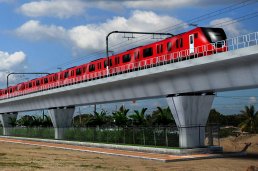First appeared in

Asian Development Bank
100 Climate Actions from Cities in Asia and the Pacific
In an effort to reduce private vehicle dependence and pave the way for reduced transport sector emissions, the Philippines is investing in new rail lines surrounding the capital.
In an effort to reduce private vehicle dependence and pave the way for reduced transport sector emissions, the Philippines is investing in new rail lines surrounding the capital.
The project supports the construction of 53 kilometers of the North-South Commuter Railway, which will connect the regional center of Clark in central Luzon with Manila, the capital, and Calamba, located in Laguna. The government is developing Clark and New Clark City as a regional growth center. New Clark City will accommodate 1.2 million residents and 800,000 jobs by 2045, and will become an administrative center and education hub for the country.
60K
TONS OF CO₂ EQUIVALENT REDUCTION PER YEAR
The new railway line will not only reduce the reliance on private vehicles for commuters heading into Manila, but will also boost the economic opportunities for areas outside the capital city. Once complete in 2024, the new railway is expected to cut the travel time between Clark and Manila down to one hour from the three it can take by bus.
It will also be designed with the risk of flooding and natural disasters in mind. The elevated alignment on viaducts will protect the line from inundation and increase safety by preventing collisions between cars and trains. Slope stabilization will also help to prevent landslides, and vegetation strategies can protect soil from severe erosion.
The new railway is the single largest project financing of ADB in the Philippines and Asia. ADB provided a loan of $2,750 million with co-financing from the Japan International Cooperation Agency (JICA) of $2,011 million.

The railway will spur economic development in the corridor and foreign direct investments in Clark (photo by Department of Transportation, Republic of the Philippines, Japan International Cooperation Agency (JICA), and the JICA Design Team).
The Challenge
Commuter railways operate only in metro Manila and the Laguna province with no northbound railway linking the capital region with central Luzon, leading to congestion and air pollution.
Co-Benefits
Health The new railway will provide more environmental-friendly transportation options improving air quality for citizens and reducing adverse health conditions.
Social All stations will have features to provide universal access for the elderly, children, and people with disabilities
Economic It is believed that the construction activities will create 23,900 jobs, and the operation of the railways will provide further employment opportunities for more than 1,400 people.

